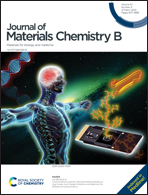Modeling cancer metastasis using acoustically bio-printed patient-derived 3D tumor microtissues†
Abstract
Cancer metastasis causes most cancer-related deaths, and modeling cancer invasion holds potential in drug discovery and companion diagnostics. Although 2D cocultures have been developed to study cancer invasion, it is challenging to recreate the 3D cancer invasion of an individual cancer patient. Here, we report an acoustic bioprinting technology that can precisely construct tumor microtissues for modeling cancer invasion in 3D. By using acoustic droplet technology, we can precisely encapsulate cancer associated fibroblasts (CAFs) derived from a colorectal cancer patient into gel droplets and print them into a 3D CAF microtissue. After depositing a tumor organoid derived from the same patient, our 3D bio-printed microtissue can be used to model cancer cell migration and invasion from the tumor organoid to the 3D CAF microtissue. We further used 3D bio-printed microtissues to investigate cancer invasion dynamics as well as their treatment response using time-lapse imaging. Thus, our acoustic 3D bioprinting technology can be widely used for establishing various microtissues for modeling cancer invasion and other diseases, highlighting its potential in personalized treatment.



 Please wait while we load your content...
Please wait while we load your content...